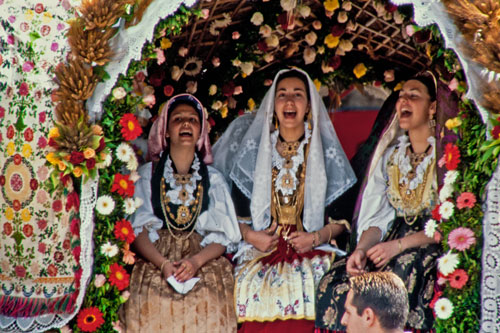Cagliari
map of Cagliari with the marked sights

As you drive into Cagliari by car, the capital of Sardinia initially presents itself as rather plain and modern.
However, once you reach the city center, Cagliari reveals itself in a completely different light: beautiful palaces with magnificent facades, shady squares with benches under palm trees, street vendors, and tiny markets.
If you arrive by ferry, you’ll find yourself right on Via Roma (photo) – in the heart of the city.
The street, paved with huge stone slabs, runs directly along the harbor. Shaded arcades line the street under the magnificent facades of classical houses.
Here, street vendors try to make their living, and charming cafes invite you to linger.

As you walk westward along Via Roma, you’ll soon notice the Palazzo Communale – the former city hall.
This building, constructed in the 19th century, boasts a neogothic style made of marble.
A short distance further, you’ll reach the Cagliari train station. Just south of it lies the central bus station.
The tumultuous history of Sardinia has left its mark on the city to this day.
However, ancient relics are scarce. Most of the preserved historical buildings date back to the periods of Pisan, Spanish, and Piedmontese rule.
The “Castello”

The fortress in the heart of Cagliari was originally built by the Pisans. Massive walls still encircle this district today, with only a few entrances leading inside.
During the Spanish rule of Sardinia, Sardinians were forbidden from living here – the houses inside the Castello were reserved for the Spaniards. Even afterward, practically only nobles, ecclesiastical dignitaries, and government officials resided behind the walls.
In the 19th century, space within the walls became scarce, prompting the construction of palaces in the harbor district.
Over time, the Castello fell into disrepair. Dark alleys with dilapidated, damp houses still partly characterize the area today.
However, in recent years, extensive restoration efforts have been underway, and many of the stately homes are already gleaming with renewed splendor.
Bastione Saint Remy

At the southern end of the Castello, the defensive structures were dismantled at the end of the 19th century, and a marble staircase was built, leading to a huge viewing platform.
As an alternative to the stairs, a lift was constructed.
Up here, half of Cagliari gathers in the evenings, and small markets and concerts take place.
Trees provide shade, and many benches invite you to rest. The Bastione is an ideal starting point for exploring the old town.
From here, you can see the dome of the cathedral, which stands just a short distance above, directly on the edge of the Castello.
Cathedral of Santa Maria

The Cathedral is the bishop’s church of Cagliari. It was initially built by the Pisans at the beginning of the 13th century in the Pisan-Romanesque style.
Already in the 14th century, the first renovations were made in the Catalan-Gothic style.
The most significant changes were made around 1700 by the Spaniards, who redesigned the interior and facade in the Baroque style.
The facade became dilapidated at the beginning of the 20th century and was demolished in 1903.
It was reconstructed in 1933, with inspiration drawn from the original Pisan Romanesque style, resulting in the church being an architectural mixture of different eras.
Inside, baroque splendor prevails – with colorful marble floors, magnificent ceiling paintings, and numerous sculptures.
The altarpiece “Retablo della Crocifissione” dates back to the 16th century.
Another valuable piece is the marble pulpit by the sculptor Guglielmo, created in the 12th century for the Pisa Cathedral. The Pisans exchanged the pulpit in the 14th century and gifted the old one to the city of Cagliari. During the Spanish Baroque renovations, the valuable piece was sawn into two parts.
Also worth seeing is the crypt, whose vault is adorned with 600 different rosettes and houses approximately 300 burial chambers.
Torre di San Pancrazio

Continuing upwards from the cathedral, you’ll reach Piazza Indipendenza, where one of the two remaining Pisan defense towers stands.
These typical Pisan fortifications are open at the back to allow light in and facilitate better resupply for the garrison.
Inside, narrow wooden stairs lead to the four platforms, also constructed of wood.
Towards the front, small arrow slits serve as the only openings.
The tower is open to visitors, but only a limited number are allowed up at a time.
From the highest platform, you’ll have a magnificent view over the entire Castello, the harbor district in front of it, and far along the coast to the south.
Cittadella dei Musei

North of Piazza Indipendenza lies the Cittadella dei Musei.
Several museums await your visit on the grounds of the former arsenal.
Most famous among them is the Museo Archeologico Nazionale, which exhibits the largest collection of archaeological finds from all over Sardinia.
Additionally, the complex houses a wax museum, a museum of Siamese art, and the National Pinacoteca.
Sagra di Sant’Efisio

Every year from May 1st to 4th, the largest festival in all of Sardinia takes place. This deeply religious pilgrimage is dedicated to the martyr Efisio, who is also the patron saint of Cagliari.
Efisio was a Roman legionary who converted to Christianity and was beheaded by the Romans in Nora.
The procession is accompanied by a huge number of folk groups from across the island, dressed in magnificent costumes, playing music, and singing as they parade for hours through the center of Cagliari.
If you’re in Sardinia in early May, you should definitely attend this event. It’s the most beautiful opportunity to experience the ancient dances, costumes, and traditions of Sardinia.
In Pula and Nora, the festival takes place on the 2nd and 3rd days as well. These events are also worth a visit.
